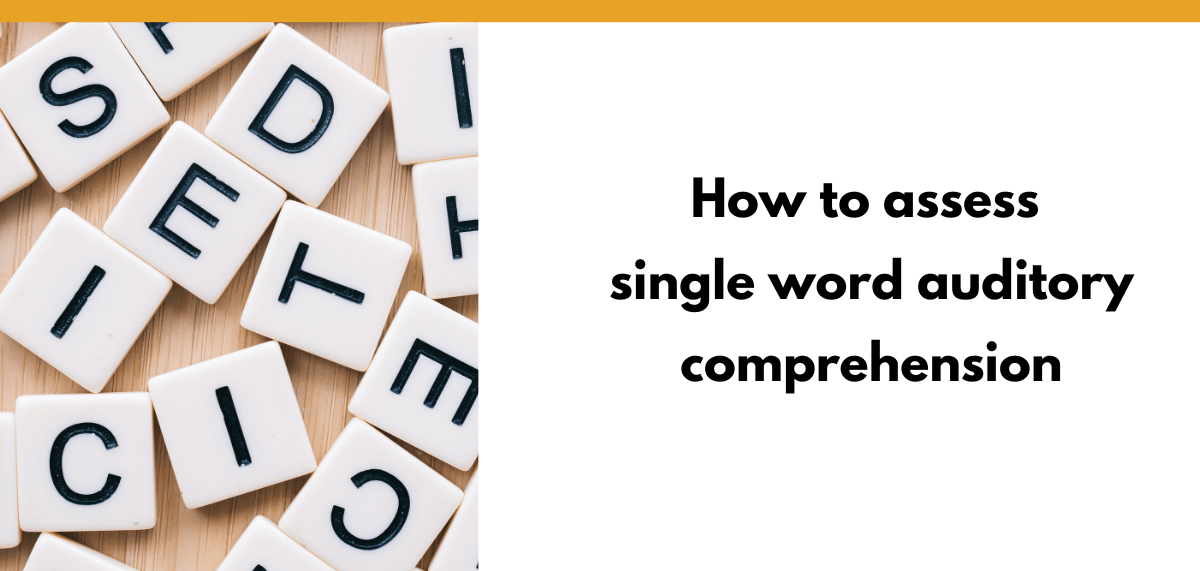Brett McCardel, MS, CCC-SLP produced an in-depth seminar “Auditory Comprehension in Aphasia: Theoretical Perspectives, Assessment, and Treatment,” which you can listen to on the MedSLP Collective Podcast. In his seminar, Brett covers assessment and treatment of auditory comprehension at the single word, sentence, and discourse levels. This post focuses on the assessment of single word auditory comprehension, but I highly recommend you listen to the full seminar.
Free DIRECT download: Assess single word auditory comprehension (clinician cheat sheet). (Email subscribers get free access to all the resources in the Free Subscription Library.)
Outline:
- A model of single word auditory comprehension.
- Step 1: Assess single word auditory comprehension.
- Step 2: Assess phonology or semantics.
- Step 3: Decide whether to assess the other domain.
- Learn more about auditory comprehension in aphasia.
- Related Eat, Speak, & Think posts.
- References.
A model of single word auditory comprehension
Brett McCardel presented the Logogen Model as a useful model for clinical practice. The Logogen Model was first proposed by John Morton in 1969 and revised by Morton & Patterson in 1980.
A “logogen” is a representation of a word in a person’s lexicon. The model describes how we recognize and understand single words from a psycholinguistic standpoint. An impairment at each level results in a different sort of error pattern.
| Logogen Model Levels of processing | Activity at each level | Impairment at each level |
| Auditory phonological analysis | Identifies individual speech sounds | Word sound deafness |
| Phonological input lexicon | Determines if the word is known or new | Word form deafness |
| Semantic system | Attaches meaning | Word meaning deafness |
The three stages of single word auditory processing are presented in the chart above. Specifically, the first level is auditory phonological analysis. In this step, we detect individual speech sounds in a word. Next, the phonological input lexicon activates and identifies if the word is known or new. Finally, processing taps into the semantic system to assign meaning to the word.
An impairment at each level results in a different type of comprehension impairment:
- Word sound deafness – difficulty discriminating between individual speech sounds.
- Word form deafness – difficulty determining if a word is known or new.
- Word meaning deafness – difficulty understanding what a word means.
Now that we have a basic understanding of single word auditory processing, let’s turn to how to assess for an impairment in one or more of these three levels.
Step 1: Assess single word auditory comprehension
We have two common tasks to assess single word auditory comprehension. The first task is often found in aphasia batteries, the second one is common in research. (McCardel, 2024)
- Matching a spoken word to the corresponding picture (spoken word-to-picture matching).
- Determining if a spoken word matches the given picture (spoken word-picture verification).
Given that we likely already administer a spoken word-to-picture matching subtest in our clinical practice (such as with the Boston Diagnostic Aphasia Examination), we can use this to our advantage in Step 2.
Step 2: Assess phonology or semantics
As a reminder, the spoken word-to-picture matching task typically provides the patient with four pictures to choose from:
- The target picture.
- A phonological distractor.
- A semantic distractor
- An unrelated foil.
So if a patient has difficulty with single word auditory comprehension from Step 1, we can dig deeper to find out which level(s) of single word auditory processing they are having trouble with. This can help direct treatment choices and compensatory strategies.
In order to do this, we can look at our patient’s errors on the spoken word-to-picture matching task. If the errors are predominately phonological, we can assess for word sound deafness or word form deafness with the SAPA (see below for details). If the errors are semantic in nature, we can assess for word meaning deafness with one of the semantic tests below. And if there is no clear pattern to the errors, we can use our clinical judgment to decide which domain to assess.
Option A: Assess phonological processing
In the Logogen Model, the first two levels involve phonological processing (auditory phonological analysis and phonological input lexicon). Brett mentions two standardized tests that are useful in assessing phonological processing:
- PALPA: Psycholinguistic Assessments of Language Processing in Aphasia (Kay et al, 1992).
- SAPA: Standardized Assessment of Phonology in Aphasia (SAPA; Kendall et al, 2010).
The PALPA is commercially available, although I was unable to find a seller online. The SAPA is open-access (link below Diane Kendall’s picture). I was unable to find norms but will update here if I do (if you have norms, please share how to access!).
| SAPA Subtest 2 | Purpose | Comments |
| Task 1: Real word rhyme decision | Useful to compare with nonword rhyme decision task | Equal difficulty = word sound deafness Real word > Nonword = word sound deafness, but person is tapping into word form knowledge to assist. |
| Task 2: Nonword rhyme decision | Test for word sound deafness | |
| Task 3: Lexical decision | Test for word form deafness | |
| Task 4: Minimal pairs decision | Test for word sound deafness | |
| SAPA Subtest 3 | Purpose | Comments |
| Task 1: Real word repetition | Useful to compare with nonword repetition | Equal difficulty = word sound deafness Real word > Nonword = word sound deafness, but person is tapping into word form or semantic knowledge to assist. |
| Task 2: Nonword repetition | Test for word sound deafness |
If our patient has difficulty with minimal pairs, we can also compare their performance with how well they do with maximal pairs. If patients perform better with maximal pairs than they do with minimal pairs, they would have a less severe impairment than patients who perform poorly with both tasks.
As a reminder:
- Minimal pairs – differ by one distinctive feature, like “tight – kite” or “bud – bug”
- Maximal pairs – differ by maximal number of features, like “face – lace” or “bud – bus”.
Option B: Assess semantic processing
Brett tells us about two tests we can use to assess single word semantic processing (McCardel, 2024):
- Pyramids and Palm Trees (from Pearson Assessments).
- Kissing & Dancing Test (APA PsycNet subscription).
- Kissing & Dancing Test (short form available from SCORE Lab at Johns Hopkins, https://score.jhmi.edu/downloads.html).
The Kissing & Dancing Test short form is 15 items. It consists of 3 black and white line drawings per page, where each drawing represents an action (verbs). There is a reference drawing at the top and two choices below. The person points to the choice that is most closely related to the reference image.
Step 3: Decide whether to assess the other domain
If our patient has impaired single word auditory comprehension (Step 1), and we dig deeper with a test of phonological or semantic impairment (Step 2), we can then choose whether to assess the other domain or to move on to intervention.
Various factors will play a role in our decision, such as:
- Do we already have enough information to have a reasonably clear idea of the impairment(s)?
- Is our patient interested in further assessment?
- How much time do we have to provide intervention?
Given that our patient could have multiple impairments and that our treatment and recommendations will differ based on whether the impairment is phonological or semantic in nature, I think we should try to assess both domains if our patient is willing and we have the time.
Learn more about assessing and treating auditory comprehension
I strongly encourage you to listen to Brett McCardle’s seminar, “Auditory Comprehension in Aphasia: Theoretical Perspectives, Assessment, and Treatment,” to learn more about assessing auditory comprehension at the sentence and discourse levels, as well as to learn about treatment at all levels of auditory comprehension.
Related Eat, Speak, & Think posts
- Single-use communication evaluation folders.
- Easy discourse measures to demonstrate improvement.
- How to assess pragmatic skills in adults with brain injury.
References
- Bak, T. H., & Hodges, J. R. (2003). Kissing and Dancing Test (KDT) [Database record]. APA PsycTests. https://doi.org/10.1037/t41470-000
- Kendall, D. L., del Toro, C., Nadeau, S. E., Johnson, J., Rosenbek, J., & Velozo, C. (2010, June). The development of a standardized assessment of phonology in aphasia. Paper presented at the Clinical Aphasiology Conference, Isle of Palm, SC. https://aphasiology.pitt.edu/2112/
- McCardel, B. (2024). Auditory comprehension in aphasia: Theoretical perspectives, assessment, and treatment [Slides from a continuing education seminar]. The Medical SLP Collective. Free access to recording: https://medslpcollective.com/podcast/webinar-auditory-comprehension-in-aphasia-theoretical-perspectives-assessment-and-treatment/
- Morton, J. (1969). Interaction of information in word recognition. Psychological Review, 76(2), 165–178. https://doi.org/10.1037/h0027366
- Morton, J. & Patterson, K. (1980). A new attempt at an interpretation, or, an attempt at a new interpretation. In M. Coltheart, K. Patterson, & J. C. Marshall (Eds.), Deep dyslexia (pp. 91-118). Routledge and Kegan Paul. https://johnmorton.co.uk/wp-content/uploads/2014/11/1980-kara-new.pdf
Free DIRECT download: Assess single word auditory comprehension (clinician cheat sheet). (Email subscribers get free access to all the resources in the Free Subscription Library.)
Featured image by inspireus from pixabay, found on Canva.com.
Lisa earned her M.A. in Speech-Language Pathology from the University of Maryland, College Park and her M.A. in Linguistics from the University of California, San Diego.
She participated in research studies with the National Institute on Deafness and other Communication Disorders (NIDCD) and the University of Maryland in the areas of aphasia, Parkinson’s Disease, epilepsy, and fluency disorders.
Lisa has been working as a medical speech-language pathologist since 2008. She has a strong passion for evidence-based assessment and therapy, having earned five ASHA Awards for Professional Participation in Continuing Education.
She launched EatSpeakThink.com in June 2018 to help other clinicians be more successful working in home health, as well as to provide strategies and resources to people living with problems eating, speaking, or thinking.



Be First to Comment